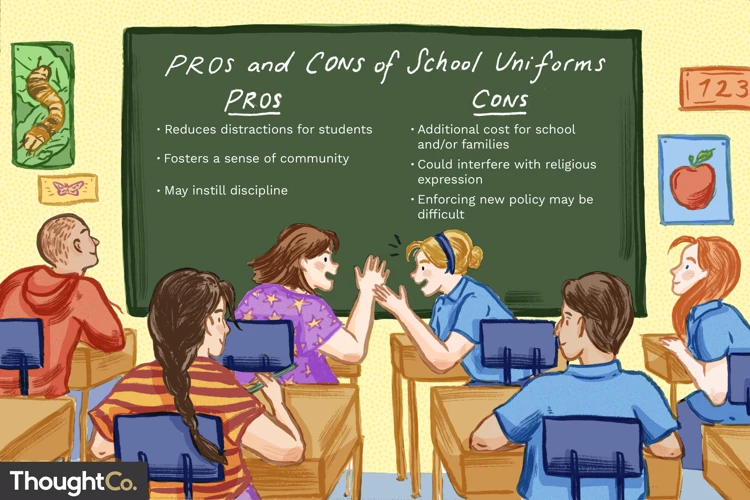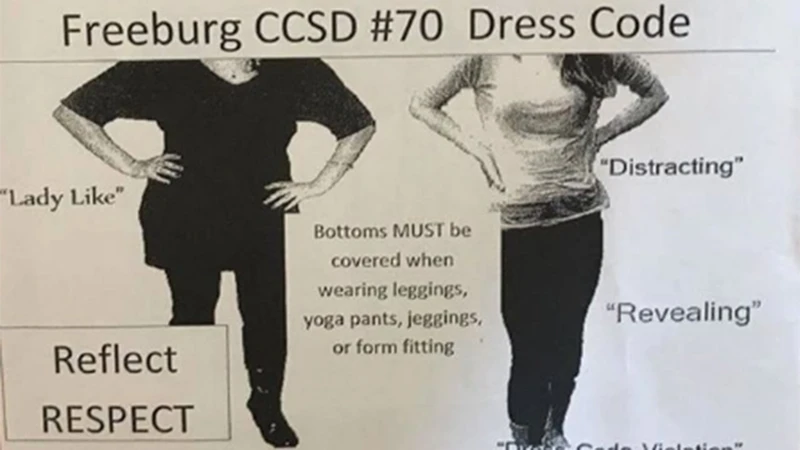As students head back to school, one topic that has been gaining attention across the globe is dress codes. While some argue that dress codes promote a professional environment, others argue that they limit self-expression and creativity. In this article, we will explore the pros and cons of dress codes, as well as the perspectives of teachers. We will also provide practical steps for taking action, including how to understand and advocate for inclusive and equitable dress codes. By recognizing the benefits and drawbacks of dress codes and prioritizing respect and dignity in the school environment, we can encourage a balanced and thoughtful approach to this complex issue.
Contents
- Pros of Dress Codes
- Cons of Dress Codes
- Teachers’ Perspectives
- How to Take Action
- Conclusion
-
Frequently Asked Questions
- FAQs
- What are the benefits of dress codes?
- What are the drawbacks of dress codes?
- Why do some schools have dress codes?
- How do dress codes affect students’ academic performance?
- Do dress codes reinforce gender stereotypes?
- How can teachers enforce dress codes while being sensitive to students’ backgrounds?
- What can students and parents do if they disagree with the dress code policy?
- Can dress codes lead to discrimination and body shaming?
- What resources are available for schools to develop inclusive and equitable dress codes?
- What is the best approach to dress codes in schools?
- References
Pros of Dress Codes

Dress codes have many benefits for students in schools. Firstly, they promote a professional environment by ensuring that students dress appropriately for school. Secondly, dress codes reduce distractions and peer pressure by eliminating the need for students to compete with one another based on their clothing. Finally, dress codes foster a sense of unity and equality among students, regardless of their socioeconomic backgrounds or personal style choices. All of these factors contribute to a safer and more productive learning environment for students. To learn about the drawbacks of dress codes, please check the Cons of Dress Codes section.
1. Promotes a professional environment
1. Promotes a Professional Environment
Dress codes have the potential to promote a professional environment that is conducive to learning. When students are dressed appropriately for school, they are better able to focus on their studies and take their education seriously. Dress codes also ensure that students are dressed in a way that is appropriate for the school environment, which can help to reduce distractions and maintain a sense of order and discipline. Additionally, having a dress code can help to prepare students for future employment, where professionalism is highly valued. By enforcing a dress code, schools can instill in their students the importance of dressing professionally and the impact it can have on their future success. However, it is important to strike a balance between promoting a professional environment and limiting students’ self-expression. Schools should consider the benefits and drawbacks of dress codes to determine an appropriate approach that prioritizes respect, dignity, and learning.
2. Reduces distractions and peer pressure
Dress codes in schools can reduce distractions and peer pressure. When students wear uniforms or follow a dress code, they don’t feel the pressure to keep up with the latest fashion trends or to wear expensive clothing to fit in with their peers. This can significantly reduce the stress and anxiety that students feel on a daily basis. Dress codes can reduce the amount of time students spend getting ready in the morning, allowing them to focus more on their studies and have a better start to the day. Dress codes can prevent students from wearing revealing or provocative clothing that could be a distraction to other students or teachers. By establishing clear guidelines for what is and isn’t appropriate to wear, dress codes can create a more professional and respectful learning environment. Dress codes are an effective way to promote a positive school culture and reduce distractions and peer pressure.
3. Fosters a sense of unity and equality
Fosters a Sense of Unity and Equality
Dress codes can create a sense of unity and equality among students. When everyone follows the same dress code, there are no visible class differences based on clothing. This can help to reduce the financial burden on families who may feel pressured to buy expensive clothes to keep up with their peers. Additionally, dress codes can encourage a sense of school spirit and pride, as students identify with their school community. When students feel a sense of belonging, they are more likely to engage in positive behaviors and academic pursuits. Dress codes can also promote a culture of respect and professionalism, as students learn to present themselves in a manner that is appropriate for academic and social settings. By fostering a sense of unity and equality, dress codes can contribute to a positive school culture and environment.
Cons of Dress Codes

One of the cons of dress codes is that they limit self-expression and creativity. Clothing is a form of personal expression, and dress codes can stifle that expression by dictating what students can and cannot wear. This can especially be a problem for students who use clothing to express their cultural or religious identity. Additionally, dress codes can reinforce gender stereotypes and cultural biases by imposing different standards on male and female students. This can lead to feelings of discomfort and alienation for students who do not fit into traditional gender roles. Finally, dress codes can result in body shaming and discrimination, as students who do not conform to the dress code may be singled out and punished. It’s important for schools to consider these drawbacks when implementing dress codes and to strive for a policy that balances the need for a safe and professional learning environment with students’ rights to self-expression and individuality.
1. Limits self-expression and creativity
One of the main arguments against dress codes is that they limit students’ ability to express themselves and be creative with their clothing choices. When students are required to wear uniforms or adhere to strict dress codes, they may feel like their individuality is being stifled. This can lead to a lack of enthusiasm for school and a decrease in self-confidence. While some argue that dress codes promote a sense of unity and equality, others argue that they can actually lead to conformity and a lack of diversity in expression. Students should be able to express themselves in a way that feels comfortable and authentic to them, and dress codes may prevent them from doing so. It’s important to consider the potential impact on students’ mental health and well-being when deciding whether or not to implement a dress code policy.
If you want to learn more about the pros and cons of different school policies, check out our article on pros of year-round school.
2. May reinforce gender stereotypes and cultural biases
Dress codes may reinforce gender stereotypes and cultural biases by dictating what is considered appropriate clothing for male and female students. For example, girls may be required to wear skirts or dresses, while boys are required to wear pants. This can perpetuate the idea that there are only two genders and that each gender has a specific way of dressing.
Dress codes may not take into account cultural or religious clothing practices, which can result in discrimination against students who are not able to conform to the dress code. For instance, some religious beliefs require women to cover their hair or wear modest clothing. If the dress code does not allow for such clothing, it can create a hostile environment for these students.
Dress codes that focus on modesty or covering up can also reinforce harmful attitudes towards women’s bodies. It can imply that girls are responsible for the way that boys behave towards them, and that they need to cover up to avoid unwanted attention. This can contribute to a culture of victim-blaming and perpetuate harmful gender stereotypes.
It is important for schools to consider the potential biases and stereotypes that can be reinforced by dress codes and to ensure that their policies are inclusive and equitable for all students. Schools should strive to create an environment where students can express themselves while respecting the diversity of cultural and religious backgrounds.
3. May lead to body shaming and discrimination
Dress codes can often contribute to body shaming and discrimination, especially towards girls and women. Dress codes that focus on covering up specific body parts can reinforce harmful societal norms and stereotypes. For example, dress codes that prohibit exposed shoulders or short skirts can send the message that girls’ bodies are inherently distracting or sexual. This can lead to girls feeling ashamed of their bodies and can contribute to a culture of victim blaming.
Dress codes can also perpetuate discrimination based on body size, race, and gender identity. For instance, dress codes that require certain body types or hairstyles can exclude students who do not fit within those narrow standards. This can lead to feelings of isolation and low self-esteem, and can contribute to a hostile school environment.
In order to address these issues, dress codes should be designed with inclusivity and equity in mind. Schools should prioritize creating dress codes that do not shame or discriminate against any particular group of students. Instead, dress codes should foster a culture of respect, dignity, and learning for all students. This can be achieved by involving students, parents, and teachers in the creation and enforcement of dress codes, and by providing resources and support for those who may be negatively impacted by dress code policies.
Teachers’ Perspectives

When it comes to dress codes, teachers have varying perspectives on the matter. Some believe that it is important to enforce dress codes in order to create a professional and respectful environment for learning. However, others emphasize the need for flexibility and sensitivity to students’ backgrounds, recognizing that different cultures and religions may have different dress requirements. Additionally, teachers should consider their own dress code and how it aligns with the school’s policies. Ultimately, teachers can play a role in promoting inclusive and equitable dress codes by starting a dialogue with students and parents, advocating for respectful and thoughtful approaches, and supporting organizations that provide resources and support. By prioritizing respect, dignity, and learning in the school environment, teachers can help create a positive and supportive atmosphere for all students.
1. Importance of enforcing dress codes
Enforcing dress codes is important for maintaining a safe and professional learning environment. Dress codes help to prevent distractions and promote better focus on learning. Schools have a responsibility to provide a safe and healthy learning environment for their students, and dress codes can help to achieve this goal. Enforcing dress codes can also help to prevent bullying and harassment based on appearance. Additionally, dress codes promote a sense of discipline and respect for authority, which can benefit students in their future careers. Teachers play a crucial role in enforcing dress codes and setting a positive example for their students. By enforcing dress codes consistently and fairly, teachers can help to create a positive and respectful learning environment that benefits all students.
2. Need for flexibility and sensitivity to students’ backgrounds
Flexibility and sensitivity are crucial when it comes to implementing dress codes in schools. While dress codes can serve a purpose in promoting a safe and professional learning environment, they can also unintentionally exclude students from certain cultural or economic backgrounds. For example, requiring expensive or specific types of clothing can be a burden for families who cannot afford it. Additionally, dress codes that prohibit certain styles or cultural attire can make students feel unwelcome or ashamed of their heritage.
To address this issue, schools should consider implementing dress codes that are inclusive and mindful of diverse student backgrounds. This can involve allowing for variations in clothing styles and materials, as well as providing resources or support for families who may need assistance in obtaining appropriate clothing. It is also important for school officials to listen to and respect the concerns of students and families who may feel marginalized or excluded by dress code policies.
Ultimately, a flexible and sensitive approach to dress codes can help to promote a more inclusive and equitable learning environment, while still maintaining the benefits of a dress code policy. By prioritizing respect, dignity, and learning, schools can create a dress code policy that serves the needs of all students, regardless of their background or economic status.
3. Consideration of teachers’ own dress code
Teachers play a crucial role in enforcing dress codes and setting an example for students. It is important for teachers to also consider their own dress code and how it aligns with the school’s policy. Teachers should dress professionally and appropriately for the school environment, while also being mindful of their own personal expression. The dress code for teachers should be clear and consistent, and take into account cultural and religious diversity. Teachers should also be sensitive to students’ backgrounds and avoid any clothing that may be deemed offensive or inappropriate. By modeling appropriate dress and behavior, teachers can help create a positive and inclusive school culture.
How to Take Action
To take action on dress codes, it is essential to start by understanding the school’s policy. This can be done by reviewing the school’s handbook or speaking with administrators. Once the policy is understood, it is important to start a dialogue with students and parents about their thoughts and concerns. Advocating for inclusive and equitable dress codes can also help promote unity and equality among students. Supporting organizations that provide resources and support can also be helpful in promoting a balanced and thoughtful approach to dress codes. Ultimately, prioritizing respect, dignity, and learning in the school environment should be the goal when addressing dress codes. By taking these steps, schools can create a safe and comfortable environment for all students.
1. Understand the school’s dress code policy
To effectively navigate a school’s dress code policy, it’s important to have a clear understanding of what is and isn’t allowed. Take the time to review the policy carefully and note any specific guidelines or restrictions. Some dress codes may prohibit certain types of clothing, such as tank tops or shorts, while others may require students to wear a specific color or style of clothing. It’s also important to understand the consequences for violating the dress code policy, which may include disciplinary action or being sent home to change.
To help ensure compliance with the policy, consider creating a summary or cheat sheet of the key points. This can be particularly helpful for younger students or those who may have difficulty remembering all of the details. Additionally, be sure to communicate with teachers and administrators if you have any questions or concerns about the policy. They can provide additional guidance and support as needed.
Understanding the school’s dress code policy is an important step in promoting a positive and respectful learning environment. By following the guidelines and working together with teachers and administrators, we can help ensure that everyone feels comfortable and supported in their educational journey.
2. Start a dialogue with students and parents
Starting a dialogue with students and parents can help to create a more inclusive and equitable dress code policy. It is important to listen to their perspectives and concerns, and to involve them in the decision-making process. This can be done through surveys, focus groups, town hall meetings, or other forms of communication. By engaging with students and parents, we can better understand their needs and preferences, and work together to find solutions that work for everyone. We can also use this opportunity to educate them on the rationale behind the dress code policy, and to address any misconceptions or misunderstandings they may have. Ultimately, a collaborative and transparent approach can lead to a more positive and supportive school environment for all.
3. Advocate for inclusive and equitable dress codes
Advocating for inclusive and equitable dress codes is an essential step towards creating a safe and supportive environment for all students. This means that dress codes should be sensitive to the diverse backgrounds and experiences of students and avoid reinforcing harmful stereotypes or biases.
One way to advocate for inclusive dress codes is to encourage schools to involve students, parents, and community members in the development and evaluation of dress code policies. This can help ensure that policies are fair and respectful, and that they reflect the unique needs and perspectives of the school community.
Another strategy is to support organizations that provide resources and support for schools seeking to create more inclusive dress codes. For example, organizations like Dress Code Equity are dedicated to promoting inclusive dress codes that celebrate diversity and encourage self-expression.
Advocating for inclusive and equitable dress codes is an important part of creating an environment that values diversity, promotes respect and dignity, and fosters learning and growth for all students. By working together, we can create dress codes that reflect the values and priorities of our communities and help us build a brighter future for all.
4. Support organizations that provide resources and support
Supporting organizations that provide resources and support is a great way to ensure that students are able to express themselves while still adhering to dress code policies. There are several organizations that work to promote inclusive and equitable dress codes, such as Dress for Success and Girls Who Code. These organizations provide students with the resources they need to dress professionally and appropriately, while also promoting self-expression and creativity.
In addition to supporting these organizations, schools can also partner with local businesses and community groups to provide students with affordable and stylish clothing options that meet dress code requirements. This can help to alleviate the financial burden that dress codes can sometimes place on families, while also promoting a sense of community and unity.
By supporting organizations that provide resources and support, schools can ensure that their dress code policies are fair, inclusive, and respectful of students’ individual identities and backgrounds. This can help to create a safe and nurturing learning environment where all students feel valued and empowered to succeed.
Conclusion
In conclusion, it is important to recognize the benefits and drawbacks of dress codes in schools. While dress codes can promote a professional environment, reduce distractions, and foster a sense of unity and equality, they can also limit self-expression, reinforce gender stereotypes, and lead to discrimination. Teachers play a crucial role in enforcing dress codes, but they must also be flexible and sensitive to students’ backgrounds. To take action, it is important to understand the school’s dress code policy, start a dialogue with students and parents, advocate for inclusive and equitable dress codes, and support organizations that provide resources and support. Ultimately, a balanced and thoughtful approach is necessary to prioritize respect, dignity, and learning in the school environment.
1. Recognize the benefits and drawbacks of dress codes
It is important to recognize the benefits and drawbacks of dress codes before making a decision about whether or not to implement them in a school. While dress codes can promote a professional environment, reduce distractions and peer pressure, and foster a sense of unity and equality, they can also limit self-expression and creativity, reinforce gender stereotypes and cultural biases, and lead to body shaming and discrimination.
Teachers have varying perspectives on the importance of enforcing dress codes, with some seeing them as necessary for maintaining a positive learning environment and others advocating for flexibility and sensitivity to students’ backgrounds. It is also important to consider teachers’ own dress code and how it contributes to the overall culture of the school.
To take action on dress codes, it is important to understand the school’s dress code policy and start a dialogue with students and parents about their thoughts and concerns. Advocating for inclusive and equitable dress codes can also be helpful, as well as supporting organizations that provide resources and support for students who may be impacted by dress code policies.
A balanced and thoughtful approach is necessary when considering dress codes in schools. Prioritizing respect, dignity, and learning in the school environment should be the ultimate goal when making decisions about dress code policies.
2. Encourage a balanced and thoughtful approach
While dress codes can have both positive and negative effects on students, it is important to approach the issue in a balanced and thoughtful way. This means acknowledging the benefits of dress codes, such as promoting a professional environment and reducing distractions, while also recognizing the potential drawbacks, such as limiting self-expression and reinforcing stereotypes.
In order to encourage a balanced approach, it is important to involve all stakeholders in the discussion, including students, parents, teachers, and administrators. By starting a dialogue and considering different perspectives, schools can create dress code policies that are inclusive and equitable for all students.
It is also important to prioritize respect, dignity, and learning in the school environment. Dress codes should not be used to shame or discriminate against students based on their appearance, gender, or cultural background. Instead, schools can promote positive values by emphasizing the importance of personal responsibility, professionalism, and mutual respect.
Ultimately, a balanced and thoughtful approach to dress codes can help create a safe and supportive learning environment for all students. By working together and being open to different ideas and perspectives, schools can develop policies that reflect their values and priorities, while also respecting the individuality and diversity of their students.
3. Prioritize respect, dignity, and learning in the school environment
Creating a dress code policy that prioritizes respect, dignity, and learning in the school environment is essential. The dress code should be designed to ensure that students feel comfortable, safe, and respected while they are learning. It is important to consider the diverse backgrounds, cultures, and identities of students, and to avoid reinforcing stereotypes or biases. The dress code should be inclusive and equitable, and should not discriminate against any student based on their gender, race, ethnicity, religion, or socio-economic background.
Enforcing the dress code policy should be done in a way that is respectful and non-punitive. Students should be informed of the dress code policy and given opportunities to ask questions or provide feedback. Teachers and staff should be trained on how to enforce the policy in a way that is sensitive and respectful of students’ backgrounds and identities.
It is also important to remember that a dress code should not be the sole focus of a school’s efforts to create a safe and respectful learning environment. Schools should prioritize education and awareness around issues such as bullying, harassment, and discrimination in order to create a culture of respect and inclusivity. By prioritizing respect, dignity, and learning in the school environment, schools can create a positive and supportive environment for all students.
Frequently Asked Questions
FAQs
What are the benefits of dress codes?
Dress codes promote a professional environment, reduce distractions and peer pressure, and foster a sense of unity and equality.
What are the drawbacks of dress codes?
Dress codes limit self-expression and creativity, may reinforce gender stereotypes and cultural biases, and may lead to body shaming and discrimination.
Why do some schools have dress codes?
Schools have dress codes to balance the need to provide a safe educational environment with freedom of expression to students. Dress codes can promote a sense of unity and equality, reduce distractions and peer pressure, and enhance punctuality and focus on study.
How do dress codes affect students’ academic performance?
Dress codes can enhance students’ academic performance by reducing distractions and peer pressure and promoting a professional environment. However, dress codes may also limit students’ self-expression and creativity, which can negatively impact their academic performance.
Do dress codes reinforce gender stereotypes?
Yes, dress codes may reinforce gender stereotypes by dictating what is appropriate attire for male and female students. This can perpetuate harmful gender norms and limit students’ self-expression and identity development.
How can teachers enforce dress codes while being sensitive to students’ backgrounds?
Teachers can enforce dress codes while being sensitive to students’ backgrounds by considering cultural and religious differences and allowing for flexibility in dress code requirements. Teachers should also communicate dress code policies clearly and respectfully to students and parents.
What can students and parents do if they disagree with the dress code policy?
Students and parents can start a dialogue with school administrators and advocate for more inclusive and equitable dress codes. They can also support organizations that provide resources and support for students and families affected by dress codes.
Can dress codes lead to discrimination and body shaming?
Yes, dress codes can lead to discrimination and body shaming by enforcing narrow and unrealistic standards of beauty and appropriateness. This can have negative impacts on students’ self-esteem and mental health.
What resources are available for schools to develop inclusive and equitable dress codes?
There are several organizations that provide resources and support for schools to develop inclusive and equitable dress codes, such as the National Women’s Law Center and the Dress Code Project.
What is the best approach to dress codes in schools?
The best approach to dress codes in schools is a balanced and thoughtful one that prioritizes respect, dignity, and learning in the school environment. Schools should consider the benefits and drawbacks of dress codes, communicate policies clearly and respectfully, and allow for flexibility and sensitivity to students’ backgrounds.







